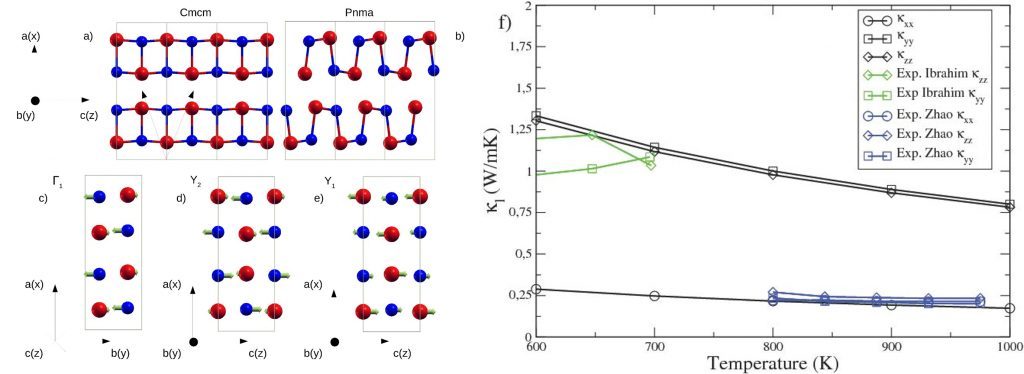Unveiling the nature of the record thermoelectric Tin- Selenide
Thermoelectricity is an interesting material property that allows to transform waste heat into electricity. Good thermoelectric materials need to be good electric conductors and good thermal insulators at the same time, the so called phonon glass and electron crystal. Due to the potential industrial applications of thermoelectric devices a huge research effort is devoted to enhance the thermoelectric efficiency. The intrinsic single crystal of SnSe was recently found to be the most efficient thermoelectric material. In this work we show that very strong anharmonic effects provide its low thermal conductivity, explaining its interesting thermoelectric properties. We expect similar strong anharmonic effects in other good thermoelectric materials.
At room temperature SnSe is a narrow gap semiconductor and at ~800 K suffers a structural phase transition to a phase with higher symmetry. In the high symmetry phase the electronic band gap is decreased while the thermal conductivity is kept very low, properties that provide a very high thermoelectric efficiency. Experimentally, there is discrepancy on the order of the transition, some works claim it is a first order transition and others that it is second order. There is also an experimental discrepancy about the thermal conductivity in the whole temperature range. As it is expected for an orthorhombic system, experiments by Ibrahim et al. show a very anisotropic thermal conductivity, with a value of ~1 W/mK (at 700 K) for the measurements in the YZ plane. Experiments by Zhao et al. show almost no anisotropy and very low values for the thermal conductivity (~0.3 W/mK at 800 K).
In this work, by applying the Landau Theory of Second Order Phase Transitions and the Stochastic Self-Consistent Harmonic Approximation (SSCHA) to calculate the free energy, we show that the transition is second order and it is driven by the collapse of a zone border phonon mode. By making anharmonic phonon calculations within the SSCHA we show that SnSe is a strongly anharmonic material because its phonon spectrum suffers a big anharmonic correction. On top of that, we calculate the phonon spectral functions and strongly anharmonic features are present like shoulders, broad peaks and satellite peaks deviating from the typical harmonic behavior. All these calculations will be very important to understand future inelastic scattering experiments in the high symmetry phase and other materials with second-order phase transitions.

Figure 1: Figure (a) and (b) show the XZ face of the high (Cmcm) and low (Pnma) symmetry phases respectively. Figure (e) shows the atomic displacements of the phonon mode that drives the transition between the two phases. Figure (c) and (d) show atomic displacements that are strongly anharmonic and show non-Lorentzian profiles in the phonon spectral function. Figure (f) shows the experimental and calculated lattice thermal conductivities. The green and blue lines correspond to experiments by Ibrahim et al. and Zhao et al. respectively. Black lines correspond to thermal conductivity calculations including anharmonicity at a non-perturbative level with SSCHA.
Our thermal conductivity calculations in the high symmetry phase clearly show that there is anisotropy between in-plane and out-of-plane measurements and quantitatively agree with experiments by Ibrahim et al.. Therefore, we suggest that the results by Zhao et al. may suffer from non-intrinsic effects. We also show for the first time that non-perturbative anharmonicity is very important to get a thermal conductivity in agreement with experiments.



